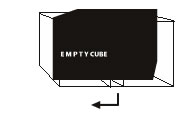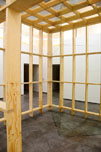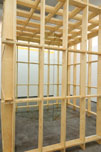FILIPE ALARCÃO
APRIL, 2, 2013

CONTACTS
geral@filipealarcaodesignstudio.com
EXHIBITION INFORMATION
EMPTY CUBE
Glass mirror and wood
Model: mixed materials
On the relation of an object with a space which is an object that stands itself in a space.
full cube
Drawing plays a structuring role in Filipe Alarcão’s work, both as an artist and as a professional designer. This seemingly redundant statement means that we should consider his work alongside certain produced objects that are directly connected with the materialisation of drawing. These objects are his Desenhos a Duas Dimensões e Meia [Two and a Half Dimensions Drawings], recently featured in Introspectiva, an exhibition at MUDE – Museu do Design e da Moda, Lisbon, 2012. To create them, Alarcão drew structures (similar to hexagonal geometric figures), whose lines fully define the objects, which are made of polished stainless steel, allowing, in the words of the artist, ‘the sides of the structures [to] merge with the support plane making the front surfaces stand out as if they were lines without depth.’
His contribution to the EMPTY CUBE project continues to explore these concerns with three-dimensionality and the spatial relationships that may emerge from it. After studying a maquette of the EMPTY CUBE space, Filipe Alarcão created a scale model of a geometric figure, a triangular prism that allows the viewer to fully grasp the form of the vitreous construction installed inside the EMPTY CUBE structure. This prismatic, reflecting structure has the same scale and proportions as the EMPTY CUBE’s architecture, mirroring it within itself as a reflecting geometric structure that offers the viewer a sensorial experience, a kind of mise en abyme that recontextualises space by creating a kind of permeability between outside and inside that revaluates its organic potentialities. Nonetheless, the use of mirrors, a recurring feature in this designer’s work, evokes a ‘modernist visuality’, as stated by Maria Teresa Cruz on the Introspectiva catalogue, from which I quote: ‘Yet the subtle play with three-dimensionality, the meticulous installation of the pieces in space, the use of mirrors (those actual vision machines), in short, the piece’s fundamental appeal to the eye of the beholder, act as a breaking away from that same modernist paradigm, somewhat reminiscent of what also occurred in contemporary art under the influence of minimalism, opticalism and installation.’ Within this sphere, the “empty cube” piece displays a reflection on the possibilities of the exhibition as a form of perceptive and sensorial experience, part of a historic genealogy that includes El Lissitzky’s Proun space (1923) or Dan Graham’s Public Space/Two Audiences (1976).
This project can also be read on two different levels. The first is found in a rapport with the word, which Filipe Alarcão uses to strengthen the notion of finding and returning to oneself that is materialised in the installation and inscribed in the title “empty cube”, which names the piece after the place and space in which it is installed, in a logic of appropriation that liberates the context, as well as its conceptual component. The second level is connected to the potential relationship the viewer may develop with the surrounding space via the installation and an element that preceded it: the model that is displayed in the space of the gallery that hosts the project, positioned in a blind angle in terms of the final structure’s reflective capabilities. The relationship between the scale of the model (the studio piece) and the installation allows us to rediscover the project-based side of Alarcão’s working process by confronting us, within the same space, with a contradictory duplication.
João Silvério
March 2013







